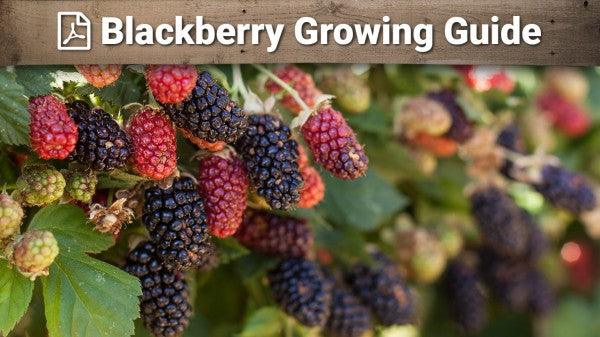Blackberries and raspberries are some of the most rewarding berries to grow in a home garden. With the right care, they will produce delicious fruit year after year. Whether you're growing black raspberries, red raspberries, or trailing blackberries, following the best planting, pruning, and maintenance techniques will ensure healthy plants and a bountiful harvest.
Click here to access the complete Blackberry Growing Guide (PDF) for detailed information on soil preparation, planting, and long-term care.
Understanding Blackberry and Raspberry Growth
Blackberries and raspberries grow on biennial canes, meaning their canes live for two years:
• First-year canes (primocanes) – Grow vegetatively and do not bear fruit.
• Second-year canes (floricanes) – Flower, produce fruit, and then die back.
Everbearing raspberries are an exception—they produce a late summer/fall crop on first-year canes and a spring crop on second-year canes.
Trailing Blackberries vs. Raspberries
• Blackberries – Retain their core when picked, resulting in a firmer fruit.
• Raspberries – Lose their core when picked, giving them a hollow center.
• Hybrid berries (e.g., boysenberries) – A mix between blackberries and raspberries, known as trailing blackberries.
Planting Blackberries and Raspberries
Best Planting Time
• Late winter to early spring – Ideal for bare-root plants.
• Fall planting – Possible in mild climates.
Soil Requirements
• Well-drained, fertile soil with high organic matter.
• pH range: 6.0–6.8.
• Avoid waterlogged areas or locations with high water tables.
Planting Instructions
• Bare-root plants: Soak roots in water before planting.
• Plant at the same depth as in the nursery row—avoid planting too deep.
• Space blackberries 3–4 feet apart, and raspberries 2–3 feet apart.
• For trailing blackberries, space 6–8 feet apart and train on a trellis.
Caring for Blackberries and Raspberries
Watering & Mulching
• Water deeply during dry periods, especially in the first year.
• Use mulch (straw, wood chips) to retain moisture and suppress weeds.
Fertilization
• Apply organic fertilizer in early spring and again after fruiting.
• Blackberries respond well to balanced organic fertilizers at blossom time.
Explore our Fertilizers & Growing Supplies collection to find high-quality organic fertilizers and soil amendments to support strong, productive berry plants.
Pruning & Training
Summer pruning:
• Remove spent second-year canes after fruiting.
• Tip first-year primocanes to encourage branching.
Winter pruning:
• Thin out weak or damaged canes.
• Train trailing varieties onto trellises for better air circulation.
Harvesting and Storage
When to Harvest
• Berries are ripe when fully colored and slightly soft to the touch.
• Pick every 2–3 days during peak season.
Storage Tips
• Store fresh berries in the refrigerator for up to 3–5 days.
• Freeze for long-term storage or make jams and preserves.
Pest & Disease Management
• Common pests: Japanese beetles, aphids, spider mites.
• Preventative measures:
- Keep plants pruned for airflow.
- Apply organic pest control as needed.
Final Thoughts: Enjoy a Bountiful Berry Harvest!
By choosing the right variety, planting correctly, and providing proper care, you can enjoy an abundant harvest of organic blackberries and raspberries for years to come. Whether you're a beginner or a seasoned gardener, following these tips will ensure strong, healthy plants and delicious fruit every season.
Additional Resources
For even more expert advice on growing blackberries and raspberries, check out these helpful guides from the Grow Organic blog:
-
🐞 Pest and Disease Management for Blackberry Plants: A Complete Guide – Learn how to identify and control common pests and diseases organically.
-
🌿 Blackberry Plant Care and Maintenance: A Complete Guide – Best practices for watering, fertilizing, and pruning your blackberry bushes.
-
🫐 A Comprehensive Guide to Blackberry Varieties – Discover the best blackberry varieties for your region and garden goals.
-
🌱 Planting and Growing Blackberries: A Comprehensive Guide – Step-by-step planting instructions to help your berry patch thrive.
-
✂️ Dormant Pruning Your Blackberries & Raspberries – Learn how to prune during dormancy to encourage better fruit production.
-
🛒 Shop Blackberry Plants – Browse Our Full Collection – Explore our curated selection of high-quality blackberry varieties available for home gardeners and orchardists.
These resources will help you grow healthy, productive berry plants and enjoy fresh, homegrown fruit for years to come. Happy planting—and grow organic for life!

